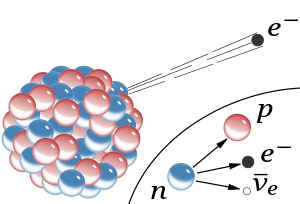
Back Desintegració de neutrons lliures Catalan Désintégration du neutron libre French Бета-распад нейтрона Russian
This article provides insufficient context for those unfamiliar with the subject. (January 2023) |

radiation, the emission of a fast electron from the nucleus (the accompanying antineutrino is omitted). In the Rutherford model for the nucleus, red spheres were protons with positive charge and blue spheres were protons tightly bound to an electron with no net charge. : The inset shows beta decay of a free neutron as it is understood today; an electron and antineutrino are created in this process.
When embedded in an atomic nucleus, neutrons are (usually) stable particles. Outside the nucleus, free neutrons are unstable and have a mean lifetime of 877.75+0.50
−0.44 s[1] or 879.6±0.8 s[2] (about 14 min and 37.75 s or 39.6 s, respectively). Therefore, the half-life for this process (which differs from the mean lifetime by a factor of ln(2) ≈ 0.693) is 611±1 s (about 10 min, 11 s).[3][4]
The free neutron decays primarily by beta decay, with small probability of other channels. The beta decay of the neutron can be described at different levels of detail, starting with the simplest:
Quantitative measurements of the free neutron decay time vary slightly between different measurement techniques for reasons which have not been determined.
- ^ Cite error: The named reference
Gonzalez-2021was invoked but never defined (see the help page). - ^ Cite error: The named reference
PDG-2020-n-lifewas invoked but never defined (see the help page). - ^ Cite error: The named reference
Beringer-etal-2012-PDG-010001was invoked but never defined (see the help page). - ^ Cite error: The named reference
PDG-2007-baryons-LPLwas invoked but never defined (see the help page).
© MMXXIII Rich X Search. We shall prevail. All rights reserved. Rich X Search